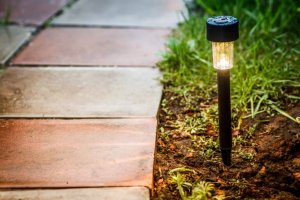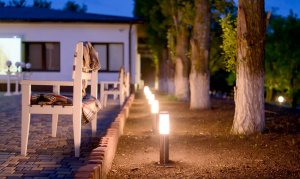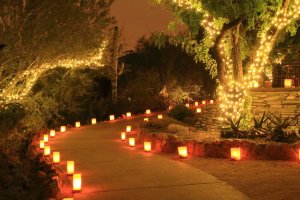Ways You Can Achieve a Well-Lit Backyard

Artificial lighting plays a very important role in achieving a well-lit backyard. During the day, sunlight is your greatest ally. At night, there are multiple ways to make areas of your backyard stand out and provide more warmth to the exterior of your home.
Functional and decorative lighting

There are two types of lighting: functional and decorative. Combine both types to create the best effects and make the trees, plants, sculptures stand out.
For a well-lit garden, you must use your imagination and be as subtle as possible so that you don’t create too bright or dark areas.
In functional lighting, the most important aspect is the quality and position of the light, not so much the design. We advise using small light posts embedded next to the steps of your house in the backyard. With pathways, we recommend illuminating them with markers.
Decorative lighting highlights elements of the backyard at nightfall. You can create a dramatic effect and spark emotion. We suggest you use dim lighting to emphasize certain areas. To do this, you should carefully study what you want to enhance.
Types of lights used for a well-lit backyard

Backyard lighting consists of:
- Lampposts – These emit light in all directions. Their light point is placed on poles between three and five meters high. The intensity of illumination is determined by the power of the light bulbs used.
- Wall lamps – Widely used to illuminate the entrances to the house or seating areas, such as patios. They are fixed to the walls and give off a diffused light that doesn’t dazzle. A variant of this type of lamp is hanging wall lamps that are suspended from the ceiling.
- Markers – These lights emerge from the ground on a small pole of approximately 60 cm. They are very practical and elegant. We recommend them to light a path.
- Reflectors – Similar to markers, but taller. They emit light directed downwards since they have a top shaped like a mushroom. They are also known as ‘mushroom lights’.
- Spotlights – Adjustable and highlights bushes, hedges, plants, and other ornamental elements. You can change the color of the bulb to create amazing effects.
- Projectors – Powerful halogen lamps used mainly for long-range lighting and to highlight decorative elements in the backyard.
- Japanese lanterns – Typical of Japanese-style gardens and low in height. They are made with natural or artificial stone.
Lighting techniques

There are many techniques you can use to light up your backyard. Some are purely functional and for safety. Others create an atmosphere and highlight certain elements. Let’s explore some of them:
- Downlighting – A generic term for any type of light that shines down on the ground. You can achieve this type of lighting with several bulbs or with a high power projector. If positioned correctly, it can emulate natural daylight.
- Uplighting – One of the most effective lighting techniques and the most decorative. It produces spectacular effects, especially when projected onto large trees or palm trees.
- Shades with intersecting lights – This consists of illuminating an area or an object with beams of light located at two intersecting points. This technique works best with downlighting.
- Silhouette projection – This highlights the silhouette of an object against a lighted wall. You must place the light behind the object.
- Lighting with emphasis – Best used for small gardens. This is very similar to concentrated light and aims to highlight interesting elements of the garden with soft lighting, such as plants, trees, or a sculpture.
- Moonlight – This is the most magical, romantic, and decorative way to illuminate an area of the backyard. It consists of placing dim lights in the tallest trees. The soft light illuminates downward and mimics a full moon night; for example, by illuminating the branches of a tree.
These are a few ways you can achieve a well-lit backyard. Let us know how these tips work for you!
Artificial lighting plays a very important role in achieving a well-lit backyard. During the day, sunlight is your greatest ally. At night, there are multiple ways to make areas of your backyard stand out and provide more warmth to the exterior of your home.
Functional and decorative lighting

There are two types of lighting: functional and decorative. Combine both types to create the best effects and make the trees, plants, sculptures stand out.
For a well-lit garden, you must use your imagination and be as subtle as possible so that you don’t create too bright or dark areas.
In functional lighting, the most important aspect is the quality and position of the light, not so much the design. We advise using small light posts embedded next to the steps of your house in the backyard. With pathways, we recommend illuminating them with markers.
Decorative lighting highlights elements of the backyard at nightfall. You can create a dramatic effect and spark emotion. We suggest you use dim lighting to emphasize certain areas. To do this, you should carefully study what you want to enhance.
Types of lights used for a well-lit backyard

Backyard lighting consists of:
- Lampposts – These emit light in all directions. Their light point is placed on poles between three and five meters high. The intensity of illumination is determined by the power of the light bulbs used.
- Wall lamps – Widely used to illuminate the entrances to the house or seating areas, such as patios. They are fixed to the walls and give off a diffused light that doesn’t dazzle. A variant of this type of lamp is hanging wall lamps that are suspended from the ceiling.
- Markers – These lights emerge from the ground on a small pole of approximately 60 cm. They are very practical and elegant. We recommend them to light a path.
- Reflectors – Similar to markers, but taller. They emit light directed downwards since they have a top shaped like a mushroom. They are also known as ‘mushroom lights’.
- Spotlights – Adjustable and highlights bushes, hedges, plants, and other ornamental elements. You can change the color of the bulb to create amazing effects.
- Projectors – Powerful halogen lamps used mainly for long-range lighting and to highlight decorative elements in the backyard.
- Japanese lanterns – Typical of Japanese-style gardens and low in height. They are made with natural or artificial stone.
Lighting techniques

There are many techniques you can use to light up your backyard. Some are purely functional and for safety. Others create an atmosphere and highlight certain elements. Let’s explore some of them:
- Downlighting – A generic term for any type of light that shines down on the ground. You can achieve this type of lighting with several bulbs or with a high power projector. If positioned correctly, it can emulate natural daylight.
- Uplighting – One of the most effective lighting techniques and the most decorative. It produces spectacular effects, especially when projected onto large trees or palm trees.
- Shades with intersecting lights – This consists of illuminating an area or an object with beams of light located at two intersecting points. This technique works best with downlighting.
- Silhouette projection – This highlights the silhouette of an object against a lighted wall. You must place the light behind the object.
- Lighting with emphasis – Best used for small gardens. This is very similar to concentrated light and aims to highlight interesting elements of the garden with soft lighting, such as plants, trees, or a sculpture.
- Moonlight – This is the most magical, romantic, and decorative way to illuminate an area of the backyard. It consists of placing dim lights in the tallest trees. The soft light illuminates downward and mimics a full moon night; for example, by illuminating the branches of a tree.
These are a few ways you can achieve a well-lit backyard. Let us know how these tips work for you!







